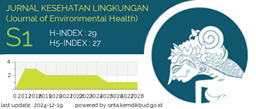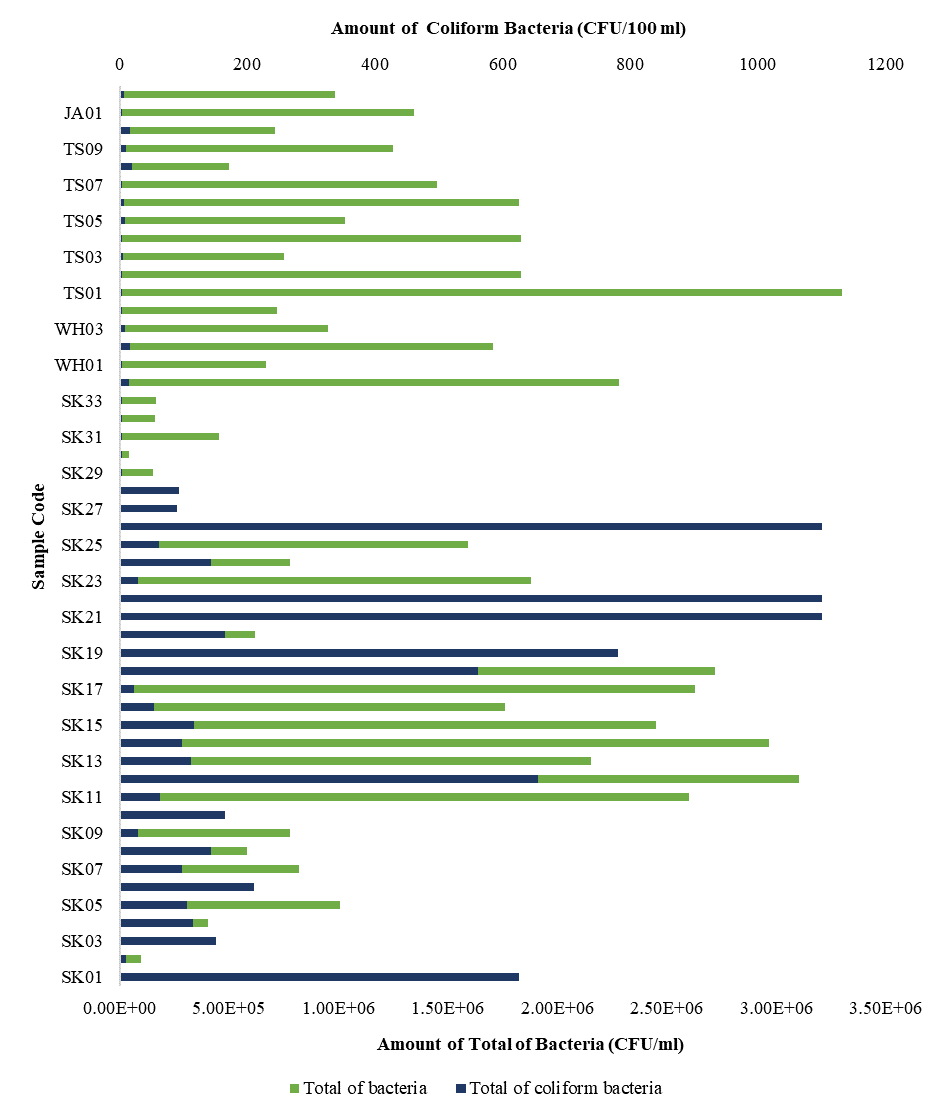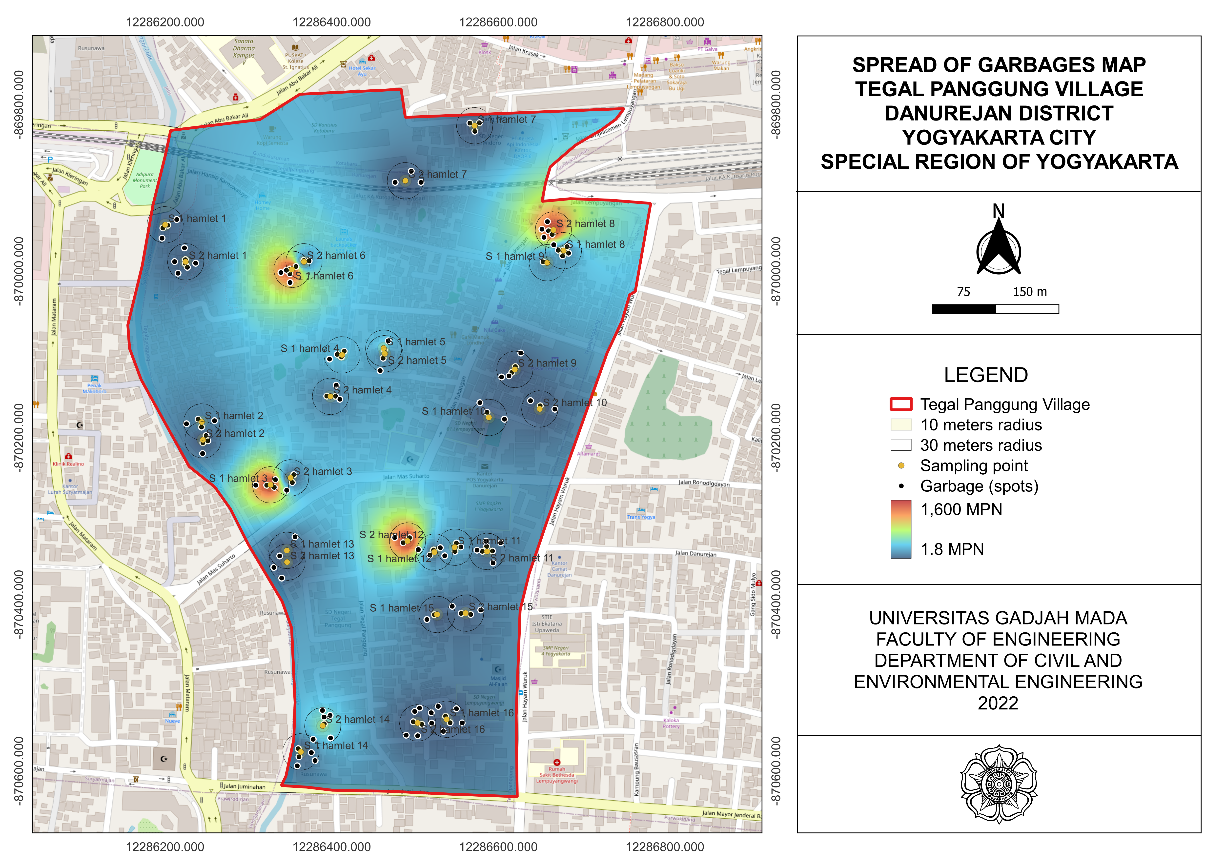Spatial Patterns of Environmental Sanitation Factors as Determinants of Toddlers' Diarrhea in Pauh District, Padang City in 2021

Introduction: The Padang City Health Office reported 9,452 diarrhea cases in 2019, 2,248 in toddlers. The Pauh District reported 413 diarrhea cases, 110 of which occurred in toddlers. Spatial analysis was used to assess environmental sanitation as determinant of toddlers' diarrhea incidence in Pauh District, Padang City. Methods: This observational study used a cross-sectional approach. The population was 4,653 toddlers, and the sample was 100 toddlers. The independent variables in this study include environmental sanitation factors such as the quality of clean water (presence of Escherichia coli), the condition and quality of the waste container, the quality and condition of sewerage, and the density of flies in the trash and household sewerage. The spatial analysis used was Moran Index I to examine the distribution pattern of variables. Results and Discussion: The incidence of diarrhea in toddlers, unstandardized household waste containers, unqualified waste sewerage, high fly density in household trash bins, and high fly density in sewerage was randomly distributed with a Moran index consecutively -0.130524; 0.315524; 0.153129; -0.174424; -0.025798. Then, clean water quality, waste management, and sewerage conditions that did not meet the requirements were randomly distributed with a Moran index of -0.158512; -0.160688; -0.117502. Conclusion: The spatial pattern of environmental sanitation factors as determinants of the incidence of diarrhea in toddlers was randomly distributed, and there was no autocorrelation found among the villages in Pauh District.
Saputri N, Astuti YP. Hubungan Faktor Lingungan Dengan Kejadian Diare Pada Balita di Puskesmas Bernung. J Ilmu Keperawatan dan Kebidanan. 2019;10(1):101−110. http://dx.doi.org/10.26751/jikk.v10i1.619
District Health Office of Padang. Health Profile of Padang City 2019. Padang: District Health Office of Padang; 2019. 1−81 p. https://dinkes.padang.go.id/profil-kesehatan-tahun-2019
Wijoyo Y. Diare Pahami Penyakit dan Obatnya. Yogyakarta: Citra Aji Pratama; 2013.
Ariani AP. Diare, Pencegahan dan Pengobatannya. Yogyakarta: Nuha Medika; 2017. 1−156 p. http://sippanon.bantenprov.go.id:8123/inlislite3/opac/detail-opac?id=28261
Ministry of Health of Republic Indonesia. Regulation of Ministry of Health of Republic Indonesia No. 50 Year 2017 about Environmental Health Quality Standards and Health Requirements for Disease-Carrying Vectors and Animals and Their Control. Jakarta: Ministry of Health of Republic Indonesia; 2017. 1–83 p.
Katiandagho D, Darwel D. Hubungan Penyediaan Air Bersih dan Jamban Keluarga dengan Kejadian Diare pada Balita di Desa Mala Kecamatan Manganitu Tahun 2015. J Sehat Mandiri. 2019;14(2):64–78. https://doi.org/10.33761/jsm.v14i2.118
Sumantri SH, Supriyatno M, Sutisna So, Widana IDKK. Sistem Informasi Geografis (Geographic Information System) Kerentanan Bencana. In: Inaqa S, editor. Jakarta: CV. Makmur Cahaya Ilmu; 2019.
Irfan A, Delima D. Sarana Sanitasi Dasar dengan Kejadian Diare pada Balita. J Sehat Mandiri. 2018;13(2):42–47. https://doi.org/10.33761/jsm.v13i2.59
Ministry of Health of Republic Indonesia. Regulation of Ministry of Health of Republic Indonesia No. 3 Year 2014 about Community Based Total Sanitation. Jakarta: Ministry of Health of Republic Indonesia; 2014.
Fikri E, Firmansyah YW, Ramadhansyah MF, Widyantoro W, Lewinsca MY, Arumdani IS, et al. Autocorrelation Spatial Diarrhea, Typhoid and Leptospirosis on The East Flood Canal, Semarang City : Moran Index Method. J Aisyah J Ilmu Kesehat. 2021;6(4):747–752. http://dx.doi.org/10.30604/jika.v6i4.734
Dewi M. Hubungan Faktor Lingkungan dengan Kejadian Diare pada Anak Balita di Wilayah Kerja Puskesmas Bati-Bati Kabupaten Tanah Laut 2020. Skripsi. Banjarmasin: Universitas Islam Kalimantan Muhammad Arsyad Al Banjari; 2020. http://eprints.uniska-bjm.ac.id/2832/
Muliawan YMRB, Prasetyo S. Spatial Analysis of Diarrhoea in Brebes District, Indonesia. International Journal of Scientific and Research Publications. 2019;9(6):530−537. http://dx.doi.org/10.29322/IJSRP.9.06.2019.p9076
Deni R. Hubungan Pengetahuan, Sikap, dan Tindakan Masyarakat dalam Penggunaan Jamban dengan Kejadian Diare di Kelurahan Sitinjak Kecamatan Angkola Barat Tahun 2019. Skripsi. Medan: Universitas Sumatera Utara; 2021. https://repositori.usu.ac.id/bitstream/handle/123456789/30919/151000177.pdf?sequence=1&isAllowed=y
Firmansyah YW, Ramadhansyah MF, Fuadi MF, Nurjazuli N. Faktor - Faktor yang mempengaruhi Kejadian Diare pada Balita : Sebuah Review. Bul Keslingmas. 2020;40(1):1–6. https://doi.org/10.31983/keslingmas.v40i1.6605
Kurniati E, Huy VT, Anugroho F, Sulianto AA, Amalia N, Nadhifa AR. Analisis Pengaruh pH dan Suhu pada Desinfeksi Air menggunakan Microbubbble dan Karbondioksida Bertekanan. J Pengelolaan Sumberd Alam dan Lingkung (Journal Nat Resour Environ Manag. 2020;10(2):247–256. https://doi.org/10.29244/jpsl.10.2.247-256
Ministry of Health of Republic Indonesia. Regulation of Ministry of Health of Republic Indonesia No. 32 Year 2017 about Environmental Health Quality Standards and Water Health Requirements for Hygiene Purposes Sanitation, Swimming Pools, Solus Per Aqua and Public Bathing. Jakarta: Ministry of Health of Republic Indonesia; 2017.
Azmi A, Sakung J, Yusuf H. Hubungan Sanitasi Lingkungan dengan Kejadian Diare pada Anak Balita di Wilayah Kerja Puskesmas Bambaira Kabupaten Pasangkayu. J Kolaboratif Sains. 2018;1(1):313–322. https://doi.org/10.31934/jom.v1i1.363
Oktora B. Hubungan Pengelolaan Sampah Rumah Tangga dengan Kejadian Diare pada Balita di Kelurahan Sindang Barang Kota Bogor. J Ilm Wijaya. 2018;10(1):47–58. https://doi.org/10.46508/jiw.v10i1.10
Iryanto AA, Joko T, Raharjo M. Literature Review : Faktor Risiko Kejadian Diare Pada Balita Di Indonesia. J Kesehat Lingkung. 2021;11(1):1–7. https://doi.org/10.47718/jkl.v11i1.1337
Notoatmodjo. Kesehatan Masyarakat Ilmu dan Seni. 2nd ed. Jakarta: Rineka Cipta; 2011.
Langit LS. Hubungan Kondisi Sanitasi Dasar Rumah dengan Kejadian Diare pada Balita di Wilayah Kerja Puskesmas Rembang 2. J Kesehat Masy. 2016;4(2):160–165. https://doi.org/10.14710/jkm.v4i2.11941
Murtadla MF. Hubungan Penyediaan Air, Pengelolaan Sampah, dan Kebiasaan Ibu dalam Mengawasi Kebersihan Tangan Balita dengan Kejadian Diare pada Balita di Wilayah Kerja Puskesmas Mangkang Semarang Tahun 2016. Skripsi. Semarang: Universitas Negeri Semarang; 2016.
Putra ADP, Rahardjo M, Joko T. Hubungan Sanitasi Dasar dan Personal Hygiene dengan Kejadian Diare Pada Balita di Wilayah Kerja Puskesmas Tasikmadu Kabupaten Karanganyar. J Kesehat Masy. 2017;5(1):422–429. https://doi.org/10.14710/jkm.v5i1.15791
Sidhi AN, Raharjo M, Astorina N, Dewanti Y. Hubungan Kualitas Sanitasi Lingkungan dan Bakeriologis Air Bersih Terhadap Kejadian Diare Pada Balita di Wilayah Kerja Puskesmas Adiwerna Kabupaten Tegal. J Kesehat Masy. 2016;4(3):665–676. https://doi.org/10.14710/jkm.v4i3.13480
Irianty H, Hayati R, Riza Y. Hubungan Perilaku Hidup Bersih dan Sehat (PHBS) dengan Kejadian Diare pada Balita. Promot J Kesehat Masy. 2018;8(1):1−10. https://doi.org/10.31934/promotif.v8i1.224
Indah FPS, Ismaya NA, Puji LKR, Hasanah N, Jaya FP. Penerapan Program Sanitasi Total Berbasis Masyarakat (STBM) dengan Kejadian Diare pada Balita. J Ilm Kesehat. 2021;20(1):10–15. https://doi.org/10.33221/jikes.v20i1.596
Nurnaningsi S, Sabilu Y, Fachlevy AF. Faktor yang Berhubungan dengan Kejadian Diare pada Balita di Wilayah Kerja Puskesmas Abeli Bagian Pesisir Kota Kendari Tahun 2017. J Ilm Mhs Kesehat Masy. 2017;2(6):1−12. http://dx.doi.org/10.37887/jimkesmas.v2i6
Soamole S. Analisis Hubungan Antara Faktor Lingkungan dengan Kejadian Diare di Puskesmas Siko Kota Ternate Tahun 2017. J Hibualamo. 2018;2(1):26–36. https://garuda.kemdikbud.go.id/journal/view/16703
Safira S, Nurmanini, Dharma S. Hubungan Kepadatan Lalat, Personal Higiene Dan Sanitasi Dasar Dengan Kejadian Diare Pada Balitadi Lingkungan Kelurahan Paya Pasir Kecamatan Medan Marela Kota Medan Tahun 2015. J Lingkung dan Keselamatan Kerja. 2016;4(3):1–10. https://www.neliti.com/id/publications/14582/hubungan-kepadatan-lalat-personal-hygiene-dan-sanitasi-dasar-dengan-kejadian-dia
Listautin L. Faktor Risiko Kepadatan Lalat dan Sanitasi Rumah dengan Kejadian Diare di Kelurahan Tanjung Pinang Kota Jambi Tahun 2017. J Ilm Univ Batanghari Jambi. 2018;18(1):208−214. http://dx.doi.org/10.33087/jiubj.v18i1.449
Andriani U. Hubungan Fasilitas Sanitasi Dasar dengan Tingkat Kepadatan Lalat pada Rumah Makan di Kecamatan Tanjung Karang Pusat Kota Bandar Lampung. Ruwa Jurai J Kesehat Lingkung. 2019;13(2):64−69. http://dx.doi.org/10.26630/rj.v13i2.2780
Copyright (c) 2022 JURNAL KESEHATAN LINGKUNGAN

This work is licensed under a Creative Commons Attribution-NonCommercial-ShareAlike 4.0 International License.
1. Copyright of all journal manuscripts is held by the Jurnal Kesehatan Lingkungan.2. Formal legal provisions to access digital articles of electronic journal are subject to the provision of the Creative Commons Attribution-ShareAlike license (CC BY-NC-SA), which means that Jurnal Kesehatan Lingkungan is rightful to keep, transfer media/format, manage in the form of databases, maintain, and publish articles.
3. Published manuscripts both printed and electronic are open access for educational, research, and library purposes. Additionally, the editorial board is not responsible for any violations of copyright law.
JKESLING by UNAIR is licensed under a Creative Commons Attribution-ShareAlike 4.0 International License.







































